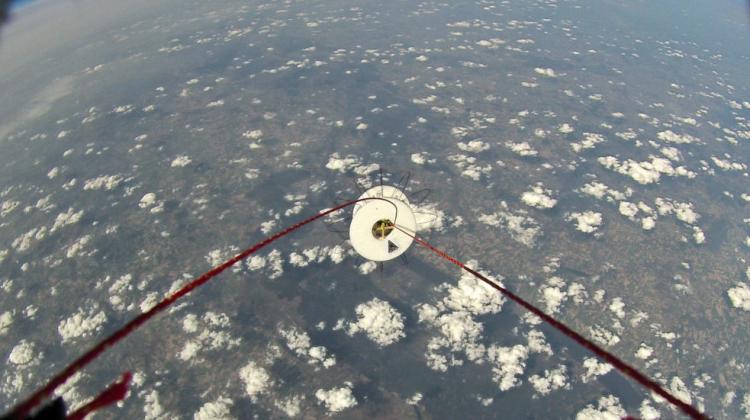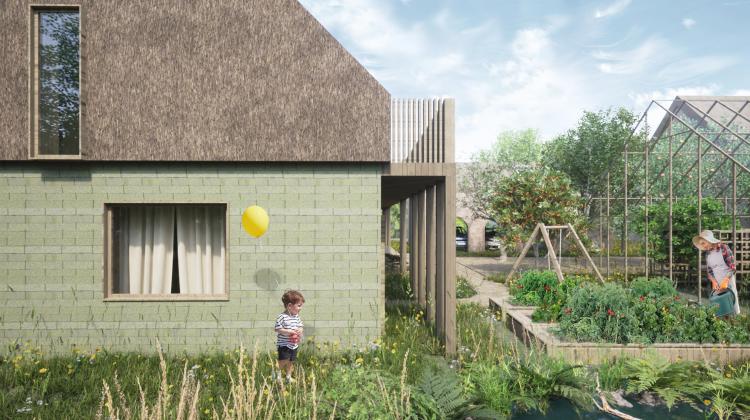JADE is best scientific experiment in the stratosphere
 Bryophytes in the stratosphere. Photo by Jędrzej Górski
Bryophytes in the stratosphere. Photo by Jędrzej Górski
Polish mission JADE was declared the best scientific experiment in international competition Global Space Balloon Challenge. As part of the mission, Polish scientists checked how living organisms cope ozone and harsh conditions in the stratosphere.
Global Space Balloon Challenge is organized annually by the Stanford Space Initiative, an organization established by Stanford University students. The competition is open to everyone, regardless of age and education. Contestants prepare their experiment and send it to the stratosphere on a balloon. The competition experiments were carried out between 10 and 27 April 2015, but final results were announced on July 21.
Polish inter-university mission JADE was launched on April 25, 2015 from the Aero Club Airport in Włocławek. Its name comes from the names of team members - Jędrzej Agata Daniel Experiment. The mission balloon carried three experiments, each prepared by a different author.
Dr. Agata Kołodziejczyk from the Institute of Environmental Sciences of the Jagiellonian University attempted to use terrestrial organisms for biomonitoring of ozone in the stratosphere. "In a biometeorological capsule I placed three species of bryophytes: Ortotrichum, Physcomitrella and Atrichum. We wanted to see which of them will be sensitive to ozone in the stratosphere, but remain resistant to low temperature, pressure or high UV radiation" - explained Dr. Kołodziejczyk.
The capsule was carried an altitude of nearly 30 km, and the entire flight lasted two hours. Control samples with the same bryophyte species remained on the ground so that later both groups could be compared. "It turned out that the bryophyte Atrichum survived well in these conditions, while ozone left characteristic brown traces on it" - explained the researcher.
While biomonitoring of ozone in the troposphere is carried out, and many plants sensitive to this compound have been characterized and even ozone gardens are created (for example at the Educational Center of NASA), so far no one has tried biomonitoring of ozone in the upper atmosphere zones.
"Studies of ozone in the stratosphere are performed with electrochemical or optical meteorological probes carried by balloons, or using satellite monitoring. These studies mainly concern the ozone hole - the enigmatic monstrosity, to which we owe the development of many technologies, including UV filters. So far, however, no research was available that would indicate a real impact of stratospheric ozone on living organisms. Only since the Indian international scientific mission of 2009 we know that life exists and develops in the stratosphere. In the times before the balloon tourism into the stratosphere, such studies seem to be justified, and bryophyte Atrichum has a chance to become the first stratospheric ozone biomarker" - said Dr. Kołodziejczyk.
Currently - on the ground - scientists are investigating the mechanisms due to which Atrichum reacts this way to ozone. "We are investigating, among other things, the relationship between ozone concentration and the number of characteristic spots on the bryophyte leaves" - said the researcher.
Another experiment awarded in the JADE mission was prepared by the representatives of Wroclaw University of Technology: Jędrzej Górski, Daniel Karczmit and Jędrzej Kowalewski. They tested sensors that collect information on temperature, pressure and UV radiation level. The sensors will be very useful in the autumn, during their next project FREDE. Then, on the balloon sent by the European Space Agency, young researchers will place equipment which will examine how quickly chlorine, which destroys the ozone layer, is released from CFCs in space.
Daniel Kaczmara from the West Pomeranian University of Technology, in the mission JADE, tested the structure of a platform for conducting remote experiments in the stratosphere. Tests included ground station software functionality and communication range.
In the category of best scientific experiments second place went to the team IRBE-1 from the Lithuanian Ventspils Augstskola. Balloon missions from around the world also received awards for the best photo taken during the experiment, the highest achieved altitude, and for best educational initiative.
PAP - Science and Scholarship in Poland, Ewelina Krajczyńska
ekr/ agt/ mrt/
tr. RL
Przed dodaniem komentarza prosimy o zapoznanie z Regulaminem forum serwisu Nauka w Polsce.















